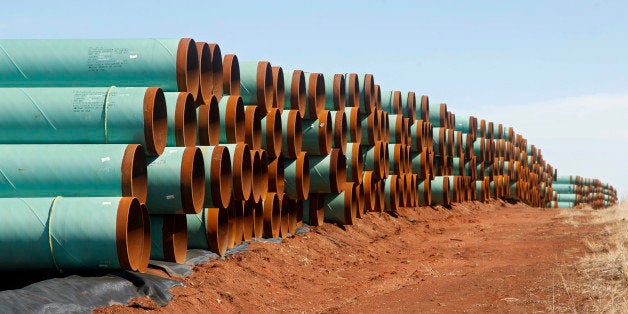
WASHINGTON -- The Environmental Protection Agency issued comments on the State Department’s environmental analysis of the Keystone XL pipeline, stating that development of the Canadian oil sands “represents a significant increase in greenhouse gas emissions" compared to other types of oil.
The State Department issued its Final Supplemental Environmental Impact Statement (FEIS) in January 2014. Agencies were given time to comment on the analysis, which was extended while the administration awaited a decision in a legal case challenging the proposed pipeline route through Nebraska.
The EPA’s assistant administrator for the Office of Enforcement and Compliance Assurance, Cynthia Giles, writes in the comments that the State Department has “made a considerable effort to evaluate the potential environmental impacts” in its most recent environmental analysis. In particular, it notes that the analysis of oil spill prevention, preparedness and response has improved over earlier analyses.
The EPA also states that the “analysis of climate change issues has also improved” over the draft environmental impact statements, making it “clear that oil sands crude has significantly higher lifecycle greenhouse gas emissions than other crudes.” The FEIS stated that oil sands crude has about 17 percent greater emissions from average crude oil in the United States. The EPA projects that the emissions generated by the oil transported through the pipeline over its 50-year lifespan “could translate into releasing as much as 1.37 billion more tons of greenhouse gases into the atmosphere.”
But the EPA is more critical of the State Department’s conclusions about the impact of Keystone XL on those emissions. The comments reference a portion of the State Department analysis that suggested that the Canadian tar sands would be developed with or without the Keystone XL pipeline in place. Approval of Keystone, or any individual pipeline, the analysis argued, “remains unlikely to significantly impact the rate of extraction in the oil sands.” The FEIS found that without the pipeline, the oil would likely be transported by rail, which is more expensive. If oil stayed in the $65 to $75 per barrel price range, the increased cost of rail shipment was not enough to have an impact on production. But if oil prices dropped below that, "higher transportation costs could have a substantial impact on oil sands production levels," according to State’s review.
The EPA notes that in the time since the report was issued, the price of oil has dropped significantly. Crude oil in the U.S. is currently selling for around $51 per barrel. This should be cause for re-evaluating the analysis of Keystone's impact on emissions, the EPA argues.
“Given recent large declines in oil prices and the uncertainty of oil price projections, the additional low price scenario included in the Final SEIS should be given additional weight during decision making, due to the potential implications of lower oil prices on project impacts, especially greenhouse gas emissions," wrote EPA's Giles.
Environmental advocates are hopeful that the EPA’s comments will force President Barack Obama’s hand in rejecting the pipeline. In a June 2013 speech outlining his climate policies, Obama said that the Keystone XL pipeline should be approved only if it "does not significantly exacerbate the problem of carbon pollution." He added that the pipeline's effect on climate “will be absolutely critical to determining whether this project will go forward."
"This oil is dirtier than just about anything on this planet, and it’s not all going to come pouring out some other way if you don’t build this giant pipeline," said Bill McKibben, founder of the group 350.org, which has organized protests against the pipeline. "This is a damning report."
Monday was the final day for federal agencies to submit their comments on the FEIS. The administration is expected to review those comments and issue a decision on the pipeline in the coming weeks.

